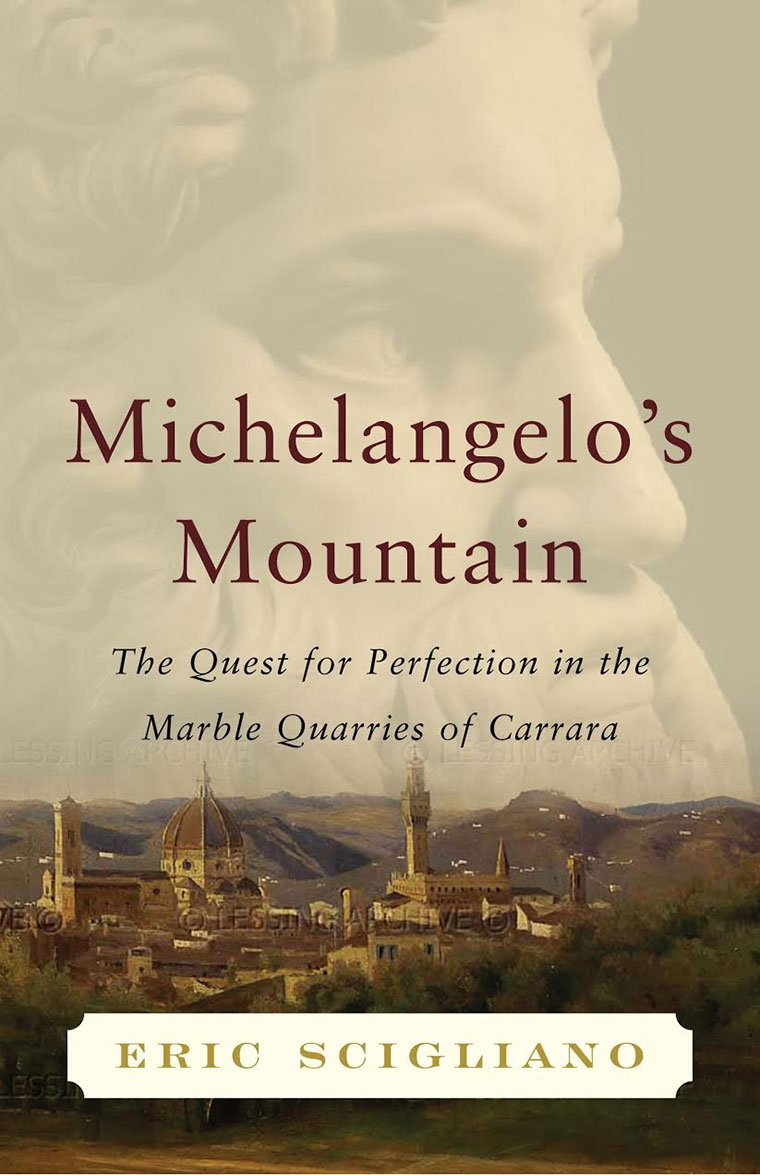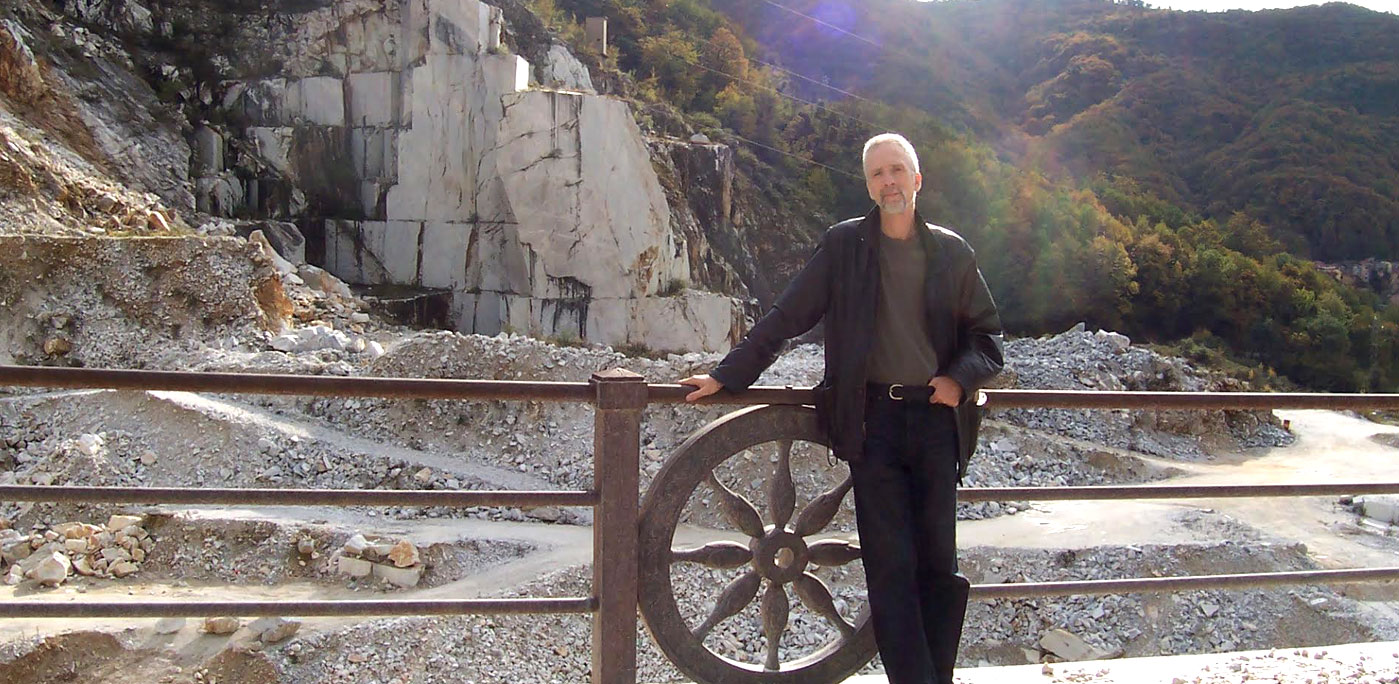Eric Scigliano has been reporting on science and environmental topics for more than 30 years. Raised in the Midwest, he arrived in Seattle in the 1970s, attracted by the city’s then-industrial working class feel and its proximity to salt water. His meticulously researched, award-winning articles have appeared in scores of publications, from Harper’s and New Scientist to the New York Times.
Scigliano is also the author or co-author of five books, including “Love, War and Circuses: The Age-Old Relationship Between Elephants and Humans,” and two books on the Pacific Northwest. In “Michelangelo’s Mountain,” he plumbs the depths of the marble quarries of Carrara, bringing to life the tumultuous career of Michelangelo as well as exploring his own family ties to the region. Published in 2005, the book was a finalist for the Washington Book Award.
What impressed you most about the setting for “Michelangelo’s Mountain?”
Carrara is both an industrial city and an art town with an unbelievably rich history. I was attracted by the sheer spectacle of it and also its very human dimension. Yet it is one of the poorest regions in the north—a northern city with a southern standard of living. It took me nearly two years to write “Michelangelo’s Mountain.” During my research, I visited the region several times, spending up to three months at a time. My cousins still work in the industry and they know everybody there.
In addition to quarrymen and stone cutters, you also have a relative who was a politician and social crusader, correct?
My family roots go back to Boston where George Achille Scigliano, my great uncle, was one of the first Italian-Americans elected to public office, initially to the Boston Common Council and then the Massachusetts Legislature. He fought for the rights of Italians and took on many businesses that exploited immigrants, including the insurance industry, fly-by-night banks and “padroni” labor contractors. For his efforts, he received death threats but instead of being cowed by them, he had the local newspaper print them. He died in 1907 at the age of 35. We wonder if he was poisoned; his widow would not allow an autopsy.
I never knew my great-uncle, of course; he died before I was born. I grew up mostly in a farming town in the Midwest where my dad was an academic at Michigan State University. Each summer, we’d go back East where I was exposed to a different world and learned more about my Italian roots. My grandmother would show me an old black-and-white photo of the Apuan Alps, near Carrara, and say: “That is where I am from.” Her father was also a sculptor and marble carver. Those kinds of memories stay with you.

“Michelangelo’s Mountain” by Seattle writer Eric Scigliano was a finalist for the 2005 Washington Book Award
Did the book on Carrara inspire a follow-up story?
I became interested in art restoration. In 2004, I was in Florence with a press contingent to witness the unveiling of Michelangelo’s newly restored David. I was even able to climb up on the scaffolding to see the statue up close. The restoration was quite troubling. The marble had been polished down to a bright white. There was little patina left to show the shadows and the richness of the skin tones. That kind of in-depth cleaning eventually could open up the marble to moisture and decay. I did extensive research on that and other restorations and ended up writing a feature story for Harper’s Magazine.
What other books have you written?
My first big book was “Love, War and Circuses,” which delves into the relationship between humans and elephants. I’ve also co-authored or contributed to three books on the marine environment, including “Flotsametrics,” which looks at ocean currents and the things they carry, and “The Wild Edge,” a coffee-table book whose photos and text explore the Pacific coastline from Baja California to the Beaufort Sea. Most recently, I was a science writer at Washington Sea Grant, a marine science program housed at the University of Washington.
I love the ocean, and I like to dive. Living in Seattle means you are very aware of the water around you. My interest in marine science was a natural part of this evolution.
Despite your success as a writer, you almost ended up a cartoonist.
I always liked to write. It was my strong suit in school. But I also enjoyed drawing and did cartoons for my high school newspaper. I went to St. Johns College in Santa Fe, N.M., a city with a lively art scene, and stayed there afterward, opening a commercial art studio with a friend. I did editorial cartoons for the local daily and then a competing weekly. On occasion, I’d help the editor out by writing feature stories. One day, he said to me: You know, you should do more writing. So I started moving in that direction. It was the era of Watergate and I was inspired after reading “All The President’s Men.” I still drew cartoons and illustrations but under pseudonyms.
Do you have a new book in the works?
I’m interested in a few projects. There’s a particular trek in Italy I’d like to do and then write about it. I’ve been kicking around ideas for historical novels set in Italy as well but it’s a bit too early to talk about those. I’d also like to write about the Arctic and how that region is affected by climate change. It would be not only a story of exploration but also about the people, the place and their predicament.
Eric Scigliano scrive di scienza e temi ambientali da più di 30 anni. Cresciuto nel Midwest, è arrivato a Seattle negli anni Settanta, attratto dal sentimento cittadino, allora molto vicino alla classe operaia, e dalla prossimità all’acqua salata. I suoi articoli, meticolosamente ricercati e premiati, sono apparsi in molte pubblicazioni da Harper’s e New Scientist al New York Times.
Scigliano è anche l’autore o il coautore di cinque libri, incluso “Love, War and Circuses: The Age-Old Relationship Between Elephants and Humans” e due libri sul Nordovest Pacifico. In “Michelangelo’s Mountain”, sonda le profondità delle cave di marmo di Carrara, portando alla vita la carriera tumultuosa di Michelangelo così come esplorando i suoi legami familiari con la regione. Pubblicato nel 2005, il libro è stato finalista per il Washington Book Award.
Cosa la impressionò maggiormente del luogo per “Michelangelo’s Mountain?”
Carrara è sia una città industriale sia una città di arte, con una storia incredibilmente ricca. Fui attirato dallo spettacolo puro e semplice ed anche dalla sua dimensione molto umana. Tuttavia è una delle regioni più povere nel Nord – una città settentrionale con un standard di vita meridionale. Mi sono serviti quasi due anni per scrivere “Michelangelo’s Mountain”. Durante la mia ricerca, ho visitato molte volte la regione, passandoci fino a tre mesi alla volta. I miei cugini ancora lavorano nell’industria e là conoscono tutti.
Oltre a scavatori e tagliatori di pietra, ha anche un parente che è stato un politico e che si è speso per battaglie sociali, corretto?
Le mie radici familiari tornano a Boston dove Giorgio Achille Scigliano, mio prozio, fu uno dei primi italo-americani eletti in un ufficio pubblico, inizialmente al Boston Common Council e poi alla Massachusetts Legislature. Lui lottò per i diritti degli italiani e affrontò molte aziende che sfruttavano gli immigranti, incluso l’industria delle assicurazioni, le banche effimere e i “padroni” che davano lavori. Per i suoi sforzi, ricevette minacce di morte ma invece di esserne atterrito, aveva il giornale locale che le stampava. Morì nel 1907 all’età di 35. Ci chiediamo se sia stato avvelenato; la vedova non permise un’autopsia.
Chiaramente, non conobbi mai il mio prozio; morì prima che io nascessi. Io sono cresciuto prevalentemente in una città agricola del Midwest dove mio padre era un accademico alla Michigan State University. Ogni estate, tornavamo a Est dove ero esposto a un mondo diverso e dove imparai di più sulle mie radici italiane. Mia nonna mi mostrava una vecchia fotografia in bianco e nero delle Alpi Apuane, vicino a Carrara e diceva: “Io arrivo da lì.” Suo padre era anche scultore e intagliatore di marmo. Questo genere di ricordi resta con te.

“Michelangelo’s Mountain” by Seattle writer Eric Scigliano was a finalist for the 2005 Washington Book Award
Il libro su Carrara ha ispirato un seguito della storia?
Mi sono appassionato al restauro d’arte. Ero a Firenze con un gruppo di giornalisti per presenziare allo scoprimento del David di Michelangelo appena restaurato nel 2004. Fui anche possibile salire su un ponteggio per vedere da vicino la statua. Il restauro era stato abbastanza problematico. Il marmo era stato levigato fino a un bianco brillante. Era stata lasciata una piccola patina per mostrare le ombre e la ricchezza dei toni di pelle. Quel genere di pulizia profonda poteva eventualmente rendere il marmo sensibile all’umidità e al decadimento. Io feci una ricerca estesa su ciò e sugli altri restauri e finii per scrivere una storia particolare per Harper’s Magazine.
Che altri libri ha scritto?
Il mio primo grande libro è stato “Love, War and Circuses” che scavava nelle relazioni tra creature umane ed elefanti. Sono stato anche co-autore o ho contribuito a tre libri sull’ambiente marino, incluso “Flotsametrics” che studia le correnti degli oceani e le cose che portano, e “The Wild Edge,” un volume illustrato le cui fotografie e testo esplorano la linea costiera del Pacifico dalla Baja California al Beaufort Sea. Più recentemente, sono stato scrittore di scienza per Washington Sea Grant, un programma di scienza marina dell’Università di Washington.
Amo l’oceano, e mi piace tuffarmi. Vivere a Seattle vuole dire essere molto consapevole dell’acqua circostante. Il mio interesse nella scienza marina è stata una parte naturale di questa evoluzione.
Nonostante il suo successo come scrittore, è diventato un disegnatore di cartoni.
Mi piace scrivere da sempre. Era il mio punto forte a scuola. Ma mi piaceva anche disegnare e facevo vignette per il mio giornale del liceo. Sono andato al St. Johns College di Santa Fe, N.M., una città con una vivace scena artistica, e ci rimasi anche dopo, quando aprii un studio di arte commerciale con un amico. Facevo vignette editoriali per il quotidiano locale e poi per un settimanale di gare. Occasionalmente, aiutavo l’editore scrivendo storie particolari. Un giorno, lui mi disse: “Sai, dovresti scrivere di più”. Quindi cominciai a muovermi in quella direzione. Era l’era del Watergate ed io fui inspirato dopo avere letto “Tutti gli uomini del Presidente.” Io disegno ancora vignette ed illustrazioni ma sotto pseudonimi.
Ha un nuovo libro in cantiere?
Sono interessato in alcuni progetti. C’è un particolare sentiero in Italia che gradirei seguire e poi scriverne. Ho anche idee per romanzi storici ambientati in Italia ma è un po’ troppo presto per parlare di quelli. Vorrei scrivere anche sull’Artico e su come quella regione è colpita dal cambiamento climatico. Non sarebbe solo una storia di esplorazione ma anche sulle persone, il luogo e la loro difficile situazione.































